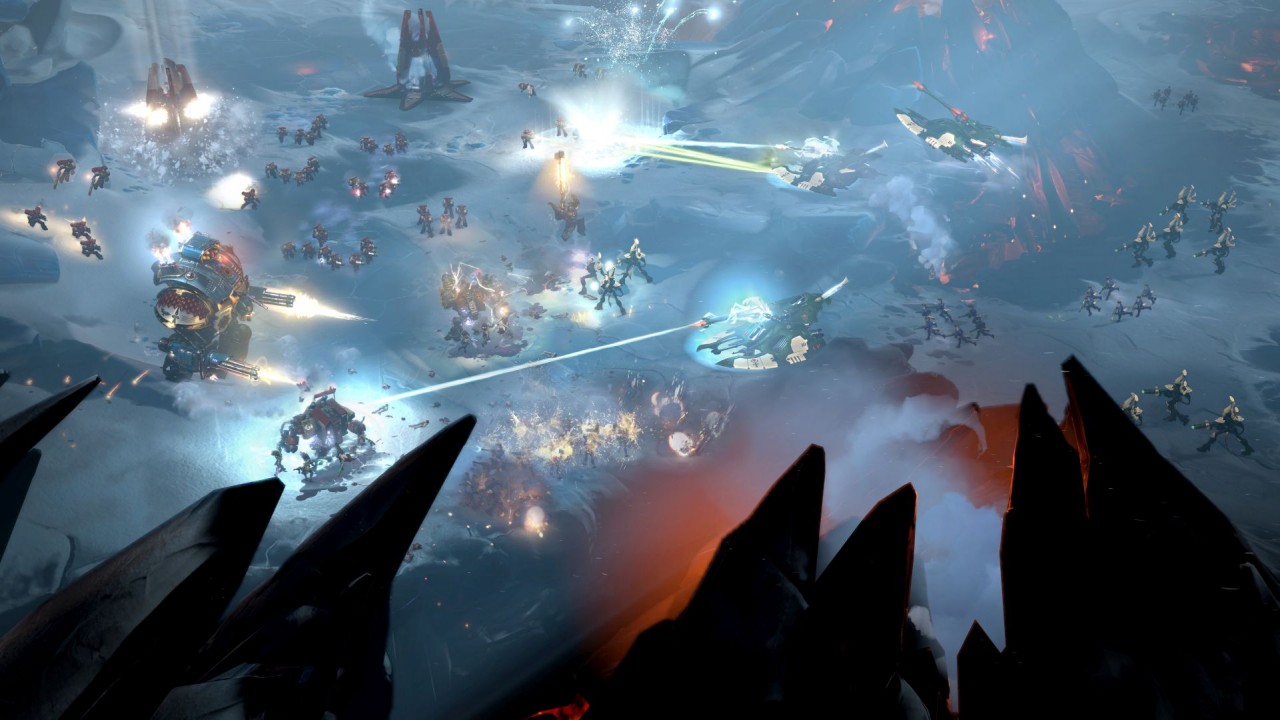I’m not great at strategy games. No, I’m terrible at strategy games. To play against me, essentially, is to win. As such, it’s been a while since I dug into one. Also, my experience with Warhammer and Warhammer 40K is limited mostly to being impressed and dismayed by how expensive the minis are when I visit my local tabletop gaming shop.
When I talked to Dawn of War III game director Phillippe Boulle about his upcoming Warhammer 40K title, I wanted to find out a bit about how is team approaches being part of such a huge franchise and how self-proclaimed noobs like myself can enter the fray despite a lack of experience.
“Dawn of War and 40K are great franchises,” said the 25-year-long fan of the property. “But it’s easy to get overwhelmed. There’s 30 years of lore – where am I supposed to start? What am I supposed to do? We call that the wall of lore.”
“The philosophy we’ve taken,” he explained, is to “go back to the things we fell in love with in the first place. There was a time I knew nothing about it, when I saw that mini in the store, and said, ‘I want to know more about that.’
To do that, the team is highlighting the big heroes of the franchise, the most interesting characters, and putting them at the center. In the demo I watched, a marine named Gabriel Angelos was at the front lines. This is also what separates a game like Dawn of War from something like Total War: Warhammer. The Total War games are about the long view, the whole army. Thousands of units clash on-screen and you watch whole battle unfold. In Dawn of War, you’re in control of something more like a platoon. Things get wild on screen pretty quickly, but that’s exactly why people are fans of these games.
That leads into what Dawn of War III is doing to welcome in players who might sometimes feel overwhelmed by these games.
One thing the team is focusing on is “battlefield readability,” or being able to tell what’s going on among all the explosions, gunfire, and blood.
“There’s always going to be a lot going on on the screen, that’s a fundamental part of this type of strategy game. We need to create ways for you to parse this information – what’s the most important thing to look at,” Boulle said. As an example, Boulle focused in on the way the player interacts with grenades.
“You issue the command, one guy moves, there’s like a three-pixel-wide grenade that goes in an arc. Maybe there’s a little smoke. Then boom, there’s this giant explosion. That feels pretty good for the guy throwing the grenade, but it doesn’t feel so good if you’re on the other side. We’ve gone back and spent a lot of time [asking], ‘what’s the most important gameplay element at this moment and how do we highlight that?’ That’s about serving all players, but for new players it means there isn’t this huge hurdle of learning what to filter out.”
The other big hurdle is the transition point. First you have to pull players into the lore, then help them parse the chaos of battle effectively. Then you have to pull them into multiplayer. This is something just about every multiplayer game struggles with – preparing those starting with the campaign for multiplayer.
While Boulle couldn’t talk much about multiplayer itself, he did address this in particular.
“There’s always going to be differences [between the campaign and multiplayer], but we want to be up front about those. The basic tools you’re going to play with are the same in single player and multiplayer, you’ll learn how units work. But yes, obviously the opponents will use them in different and more creative ways because they’re humans, but you’re definitely more prepared for having going through the campaign. That’s one of the reasons we introduce all three factions quickly, take you through those factions – so you can understand what it’s like to fight against them and to use them, which one might appeal to your play style, which one you might want to try in multiplayer.”
As for fans of the past games, they can look forward to a couple neat features. One is the return of base building. In the campaign, you can build forward bases for some interesting push and pull gameplay, while the role of bases in multiplayer remains more traditional.
You can also look forward to some absolutely massive units that, while not a ‘win button,’ will definitely be able to change the flow of the battlefield. They’re huge, and they look awesome.
Dawn of War III is headed to PC sometime in 2017.















